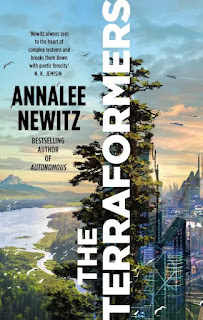The Terraformers
Annalee Newitz
Orbit, 2 February 2023
Available as: PB, 338pp, audio, e
Source: Advance copy
ISBN(PB): 9780356520865
Annalee Newitz
Orbit, 2 February 2023
Available as: PB, 338pp, audio, e
Source: Advance copy
ISBN(PB): 9780356520865
I'm grateful to Orbit for an advance copy of The Terraformers to consider for review.
The Terraformers is, I think, Newitz's first book for several years and it is really good to see a new work from this author. It is an excellent of example of all that SF can be at its best - challenging, laden with breathtaking ideas, and epic in scale and conception (though in this case not length - it's refreshing to meet a book with a span of centuries and a planetary scale narrative that is not a trilogy).
Set some 60,000 years in the future, The Terraformers considers our future at a time when "people" have spread far and wide across the universe. Post the "Great Bargain" other forms of life than humanity - animals and plants, as well as various AIs, bots and hybrids of bio, tech and AI - qualify as "people" and are entitled to a say in how things are run. This activity is overseen by "Environmental Rescue Teams", ERTs, whose focus is ecology, but more than that - one might almost say theirs is the science, or perhaps the engineering, of community, in the broadest possible sense.
So this book is filled with lifeforms designed, or engineered, for particular purposes - H. Sapiens may assume they are the default, the template, but they can be designed to be ultra-receptive to networks, or reworked as H. Varialis to breathe atmospheres of carbon and nitrogen. We meet sentient, flying moose, intelligent cows with bionic legs, and a cat reporter who forms a friendship with a flying train. Newton's audacious concepts only sound bizarre out of context: in the story they arise as almost inevitable in this future, and not just as technological maybes but as actual, living, feeling and suffering - well, people, which is the point, I think.
Troublingly for a future in which such a bewildering array of life is given a voice, and one in which there is radical acceptance of individuals (Newitz presents a variety of genders and all manner of romantic connections) economic and social inequality is as bad as ever, or perhaps worse. Corporates are able to, literally, build and own people, burning in rules to keep those people in their place. The Terraformers is about, among other things, how that process - built on the rock of private ownership - comes to be challenged.
Structured as three episodes taking place over several centuries we see the development of a new planet, Sask-E, in its early days a "pristine" wilderness (only, not really), some time later with cities are being established, and then, in the third part, as those cities fall under the control of a particularly unpleasant corporate overlord pandering to a strain of H. Sapiens genetic particularity. Each time, it's ingenuity, solidarity and daring that saves the day, though most of the characters we meet don't overlap between the parts, even though these are recognisably stories of the same communities. (I was reminded rather of Asimov's earliest Foundation stories, visiting the same polity at interesting times during a long evolution, although the imaginative leaps here are much greater and the science social as much as physical).
The accent is, then, on people (of wide and diverse types) confronting "problems" - environmental, political and developmental - their interventions then being allowed to run and the results presented centuries later. A risk with such a structure could be that really, we're just being given a kind of animated history: Newitz pushes back on that by making the main characters gloriously, passionately real, giving then lives, loves and involvements that both illuminate and transcend the development of the plot. Indeed, one senses that at some levels, aspects of these people have complicated, rather than facilitated, the author's plotting - but also that at another, they are the perfect illustration of a thesis that the future is diverse, and that it needs to be diverse. The "plot" therefore accommodates variety of both forms and opinions and apparent drawbacks of that - the awkwardness of decision making in the ERTs, for example - are really strengths.
It's a complex, thought-provoking and engaging book. Though I think it won't be for everyone - the story telling is in a very particular style and often the viewpoint characters are far form driving the plot - it's a style that grew on me and that really pays off, suiting both the setting of the book and the duracxtion of the storyline. And behind that, Newitz really is a clever and accomplished storyteller, giving us something genuinely different and ultimately breathtaking.
Wonderful reading.
For more information about The Terraformers, see the publisher's website here.

No comments:
Post a Comment